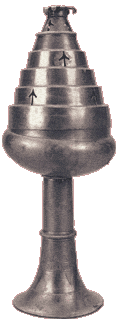 |
THE STEPPED
lids of the incense burners are probably an Achaemenid Persian
feature, matched in relief sculptural representations at Persepolis
(in the Treasl1ry scene of Darios I and Xerxes). The horizontal
fluting on the stand of no. 71 is probably Achaemenid, although
such fluting might also be Lydian. The slender articulated stand
has general parallels in standing incense burners of Greece, like
the bronze examples from Troy and many illustrated in vase painting
(including an East Greek black-figure fragment reportedly from
Clazomenae on the Ionian coast). The type of incense burner with
conical foot may well have a Phoenician origin.
STANDING incense burners were occasional adjuncts of banquets
and symposia. Two appear in Assurbanipal's banquet scene on an
Assyrian relief from Nineveh.
The presence of nos. 71 and 72 in the Ikiztepe funeral assemblage
may be due to the banquet or symposium associations of Anatolian
burial (with couches and drinking sets), as illustrated at Karaburun,
where the funeral couch is represented as a banquet / symposiurn
couch and juxtaposed with a banquet or symposium scene in the
wall painting above.
|











